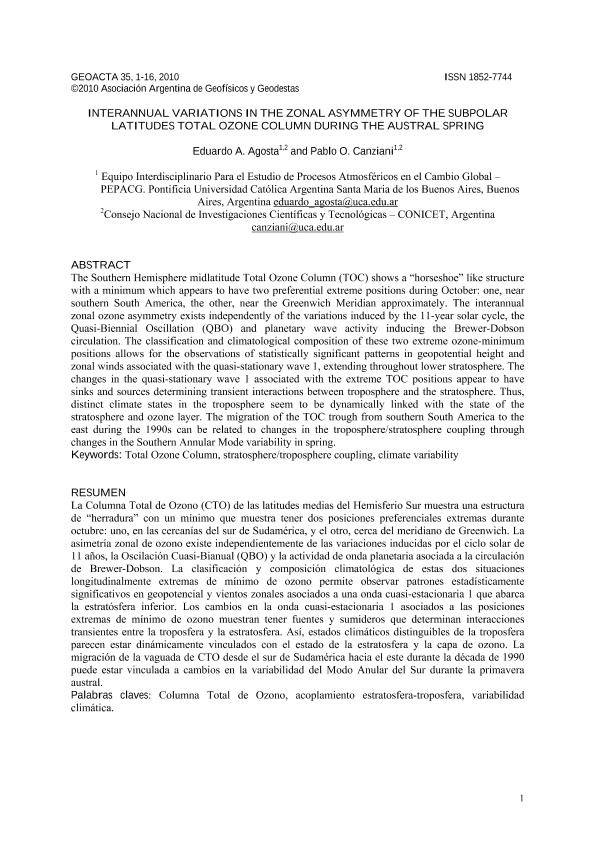Mostrar el registro sencillo del ítem
dc.contributor.author
Agosta Scarel, Eduardo Andres

dc.contributor.author
Canziani, Pablo Osvaldo

dc.date.available
2023-02-27T19:19:48Z
dc.date.issued
2010-06
dc.identifier.citation
Agosta Scarel, Eduardo Andres; Canziani, Pablo Osvaldo; Interannual variations in the Zonal Asymmetry of the subpolar latitudes Total Ozone Column during the Austral Spring; Asociación Argentina de Geofisicos y Geodestas; Geoacta; 35; 1; 6-2010; 1-16
dc.identifier.issn
0326-7237
dc.identifier.uri
http://hdl.handle.net/11336/189024
dc.description.abstract
The Southern Hemisphere midlatitude Total Ozone Column (TOC) shows a “horseshoe” like structure with a minimum which appears to have two preferential extreme positions during October: one, near southern South America, the other, near the Greenwich Meridian approximately. The interannual zonal ozone asymmetry exists independently of the variations induced by the 11-year solar cycle, the Quasi-Biennial Oscillation (QBO) and planetary wave activity inducing the Brewer-Dobson circulation. The classification and climatological composition of these two extreme ozone-minimum positions allows for the observations of statistically significant patterns in geopotential height and zonal winds associated with the quasi-stationary wave 1, extending throughout lower stratosphere. The changes in the quasi-stationary wave 1 associated with the extreme TOC positions appear to have sinks and sources determining transient interactions between troposphere and the stratosphere. Thus, distinct climate states in the troposphere seem to be dynamically linked with the state of the stratosphere and ozone layer. The migration of the TOC trough from southern South America to the east during the 1990s can be related to changes in the troposphere/stratosphere coupling through changes in the Southern Annular Mode variability in spring.
dc.description.abstract
La Columna Total de Ozono (CTO) de las latitudes medias del Hemisferio Sur muestra una estructura de “herradura” con un mínimo que muestra tener dos posiciones preferenciales extremas durante octubre: uno, en las cercanías del sur de Sudamérica, y el otro, cerca del meridiano de Greenwich. La asimetría zonal de ozono existe independientemente de las variaciones inducidas por el ciclo solar de 11 años, la Oscilación Cuasi-Bianual (QBO) y la actividad de onda planetaria asociada a la circulación de Brewer-Dobson. La clasificación y composición climatológica de estas dos situaciones longitudinalmente extremas de mínimo de ozono permite observar patrones estadísticamente significativos en geopotencial y vientos zonales asociados a una onda cuasi-estacionaria 1 que abarca la estratósfera inferior. Los cambios en la onda cuasi-estacionaria 1 asociados a las posiciones extremas de mínimo de ozono muestran tener fuentes y sumideros que determinan interacciones transientes entre la troposfera y la estratosfera. Así, estados climáticos distinguibles de la troposfera parecen estar dinámicamente vinculados con el estado de la estratosfera y la capa de ozono. La migración de la vaguada de CTO desde el sur de Sudamérica hacia el este durante la década de 1990 puede estar vinculada a cambios en la variabilidad del Modo Anular del Sur durante la primavera austral.
dc.format
application/pdf
dc.language.iso
eng
dc.publisher
Asociación Argentina de Geofisicos y Geodestas
dc.rights
info:eu-repo/semantics/openAccess
dc.rights.uri
https://creativecommons.org/licenses/by-nc-sa/2.5/ar/
dc.subject
TOTAL OZONE COLUMN
dc.subject
STRATOSPHERE/TROPOSPHERE COUPLING
dc.subject
CLIMATE VARIABILITY
dc.subject.classification
Meteorología y Ciencias Atmosféricas

dc.subject.classification
Ciencias de la Tierra y relacionadas con el Medio Ambiente

dc.subject.classification
CIENCIAS NATURALES Y EXACTAS

dc.title
Interannual variations in the Zonal Asymmetry of the subpolar latitudes Total Ozone Column during the Austral Spring
dc.type
info:eu-repo/semantics/article
dc.type
info:ar-repo/semantics/artículo
dc.type
info:eu-repo/semantics/publishedVersion
dc.date.updated
2023-02-16T13:25:20Z
dc.journal.volume
35
dc.journal.number
1
dc.journal.pagination
1-16
dc.journal.pais
Argentina

dc.journal.ciudad
Ciudad Autónoma de Buenos Aires
dc.description.fil
Fil: Agosta Scarel, Eduardo Andres. Consejo Nacional de Investigaciones Científicas y Técnicas; Argentina. Pontificia Universidad Católica Argentina "Santa María de los Buenos Aires". Secretaría Académica. Dirección de Investigaciones. Equipo Estudios de Procesos Atmosféricos en el Cambio Global; Argentina
dc.description.fil
Fil: Canziani, Pablo Osvaldo. Consejo Nacional de Investigaciones Científicas y Técnicas; Argentina. Pontificia Universidad Católica Argentina "Santa María de los Buenos Aires". Secretaría Académica. Dirección de Investigaciones. Equipo Estudios de Procesos Atmosféricos en el Cambio Global; Argentina
dc.journal.title
Geoacta
dc.relation.alternativeid
info:eu-repo/semantics/altIdentifier/url/https://revistas.unlp.edu.ar/geoacta/article/view/13601
dc.relation.alternativeid
info:eu-repo/semantics/altIdentifier/url/http://www.scielo.org.ar/scielo.php?script=sci_arttext&pid=S1852-77442010000100001
Archivos asociados
